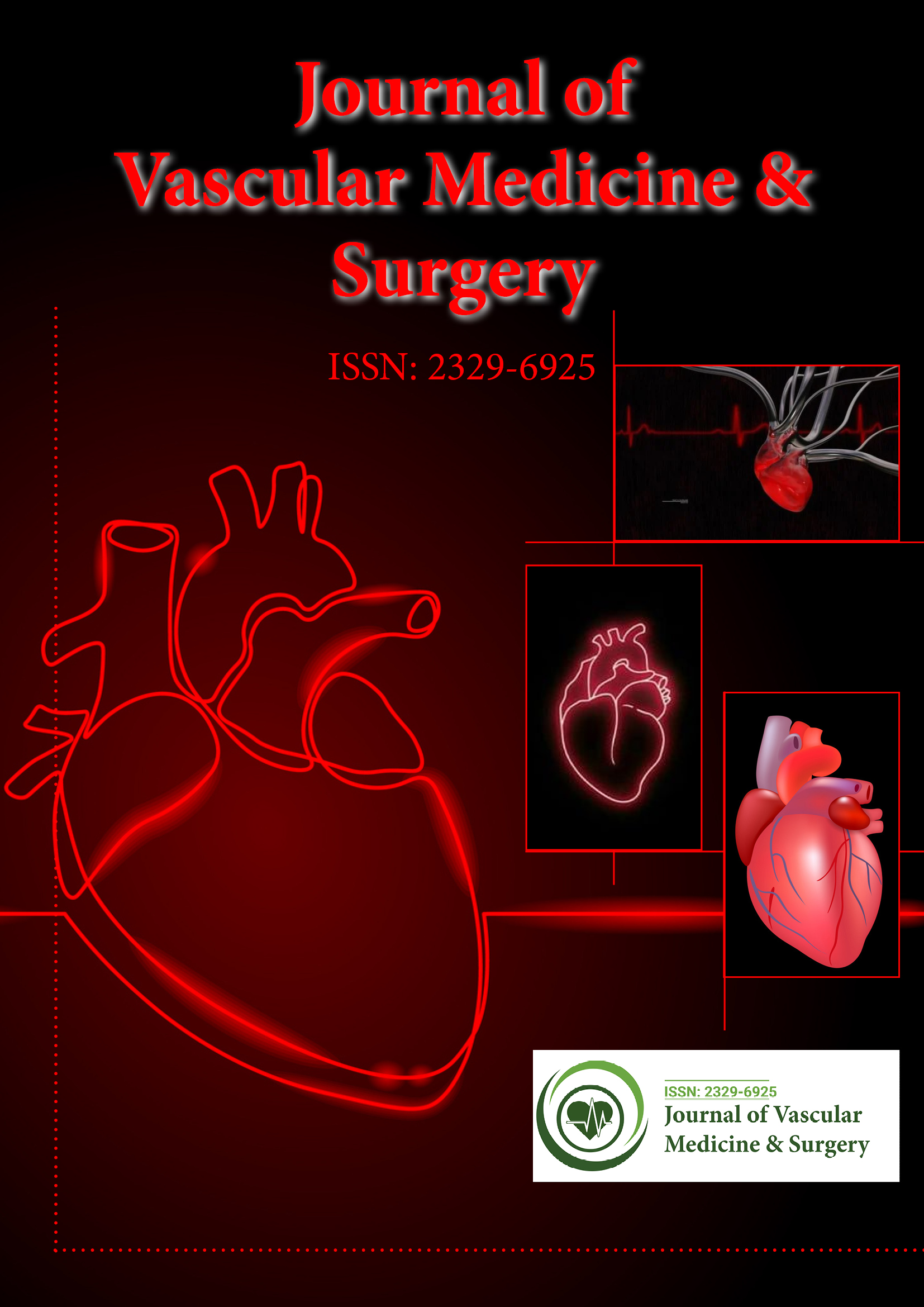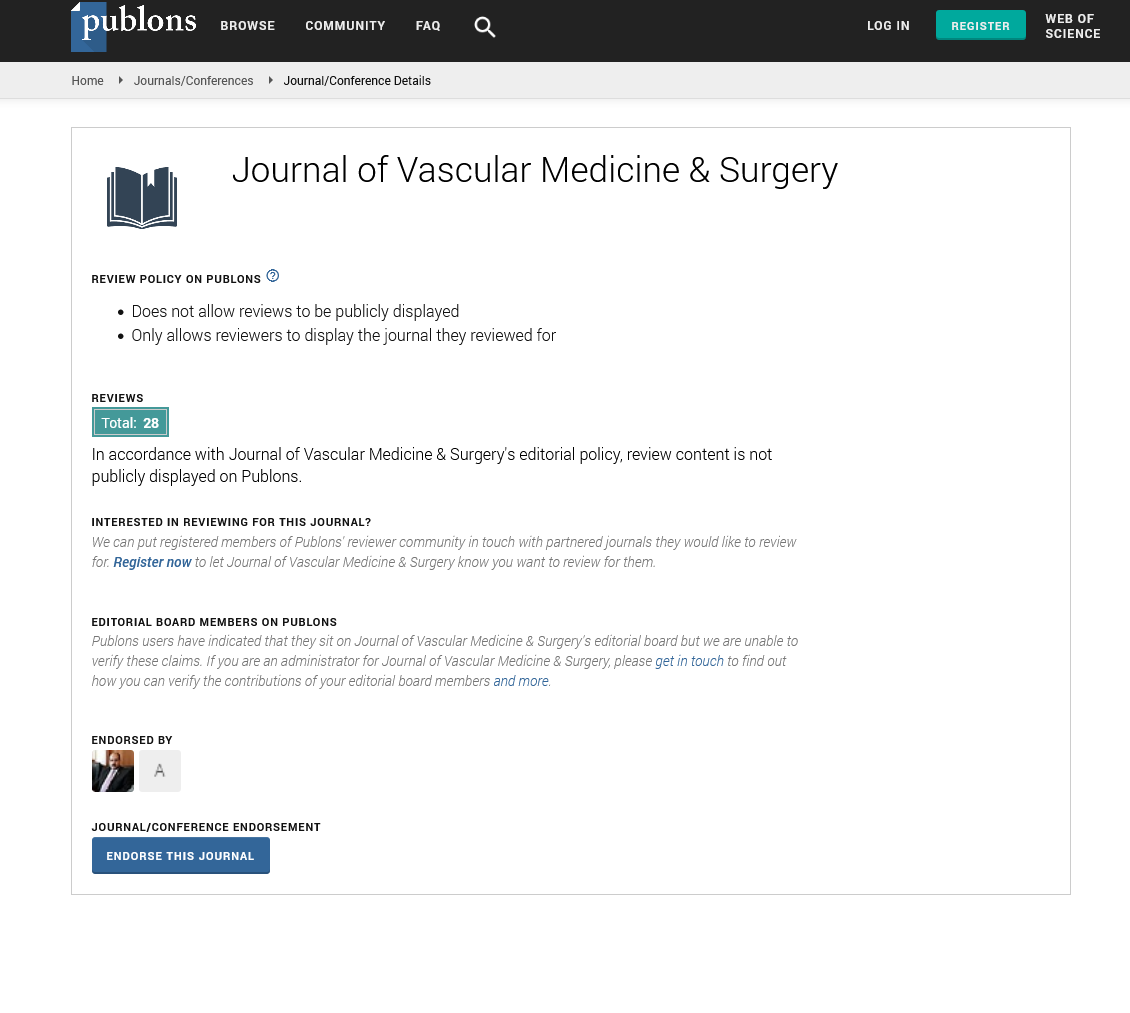Indexed In
- Open J Gate
- Academic Keys
- RefSeek
- Hamdard University
- EBSCO A-Z
- OCLC- WorldCat
- Publons
- Euro Pub
- Google Scholar
- SHERPA ROMEO
Useful Links
Share This Page
Journal Flyer

Open Access Journals
- Agri and Aquaculture
- Biochemistry
- Bioinformatics & Systems Biology
- Business & Management
- Chemistry
- Clinical Sciences
- Engineering
- Food & Nutrition
- General Science
- Genetics & Molecular Biology
- Immunology & Microbiology
- Medical Sciences
- Neuroscience & Psychology
- Nursing & Health Care
- Pharmaceutical Sciences
Short Communication - (2025) Volume 13, Issue 7
Integrating Multidisciplinary Approaches in Vascular Health Care
Runchu Aoi*Received: 25-Jun-2025, Manuscript No. JVMS-25-29912 ; Editor assigned: 27-Jun-2025, Pre QC No. JVMS-25-29912 (PQ); Reviewed: 11-Jul-2025, QC No. JVMS-25-29912 ; Revised: 18-Jul-2025, Manuscript No. JVMS-25-29912 (R); Published: 25-Jul-2025, DOI: 10.35248/2329-6925.25.13.610
Description
Vascular health care is inherently complex, involving a wide range of conditions from Peripheral Artery Disease (PAD) to aneurysms and venous disorders. These conditions often coexist with other chronic diseases such as diabetes, hypertension, and kidney dysfunction, requiring comprehensive management.
Coordinated expertise building the multidisciplinary team
At the core of effective vascular care lies the collaboration of a diverse team of healthcare professionals. This team often includes vascular surgeons, interventional radiologists, cardiologists, endocrinologists, wound care specialists, podiatrists, primary care providers, nurses, and rehabilitation therapists. Each member contributes a unique perspective and set of skills, addressing different aspects of the patient’s condition.
For instance, managing Chronic Limb-Threatening Ischemia (CLTI) — a severe form of PAD — requires surgical revascularization, advanced wound care, strict glycemic control, and often, aggressive infection management. As shown in the Global Vascular Guidelines [1], coordinated care from a multidisciplinary team dramatically improves limb salvage rates and reduces mortality.
Vascular surgeons and interventionalists are instrumental in restoring blood flow, but without proper wound care and diabetes management, revascularization alone may fail. Podiatrists play a key role in preventing and managing foot ulcers, while endocrinologists help optimize metabolic conditions like diabetes. In cases where patients are at risk of amputation, a team-based approach offers not just a second opinion, but a second chance — applying multiple strategies simultaneously to prevent limb loss.
Moreover, integrating pharmacists and case managers ensures that patients receive proper medication management and follow-up, which is critical in vascular diseases where polypharmacy is common and adherence can be challenging.
The shift toward multidisciplinary vascular care is not merely procedural — it is deeply patient-centric. Outcomes are measured not just by procedural success but by long-term functionality, independence, and quality of life. Patients with vascular diseases often suffer from reduced mobility, chronic pain, and a significant psychological burden. Integrating psychological support and physical therapy into the care model addresses these often-overlooked aspects.
Research supports the effectiveness of such comprehensive care. Demonstrated that interdisciplinary vascular care significantly improved clinical outcomes while reducing healthcare costs [2]. These findings are echoed in practice guidelines from organizations, which recommend collaborative care models for managing PAD and other vascular disorders [3].
Another critical benefit of multidisciplinary care is its role in preventing hospital readmissions. Many vascular patients, particularly those undergoing procedures like angioplasty or bypass surgery, are at high risk of readmission due to complications, poor wound healing, or unmanaged comorbidities. When specialists coordinate care and communicate across disciplines, patients receive more consistent guidance and are less likely to fall through the cracks during follow-up.
Multidisciplinary approaches also foster continuity of care. For instance, after vascular surgery, patients may need ongoing anticoagulation therapy, physical rehabilitation, and diabetes management. A fragmented care system forces patients to navigate this alone, increasing the risk of noncompliance or deterioration. In contrast, a collaborative model ensures that care is both proactive and preventive, anticipating challenges before they become emergencies.
Additionally, newer areas of vascular therapy, such as pharmacologic interventions, benefit greatly from team input. As noted by effective treatment of PAD now includes antiplatelet agents, statins, and lifestyle interventions [4]. Ensuring proper coordination between cardiologists, pharmacists, and primary care providers increases adherence and optimizes therapeutic benefit.
Multidisciplinary care is particularly crucial in vulnerable populations, including elderly patients, those with multiple comorbidities, and individuals with limited health literacy. These patients often experience fragmented care and are less able to advocate for themselves. In such cases, team-based care ensures no element of their treatment is overlooked.
Real-world application from concept to clinical practice
While the benefits of multidisciplinary vascular care are well established, implementing this model in real-world settings poses challenges. Logistical issues, institutional resistance, lack of standardized pathways, and reimbursement constraints often limit its adoption. However, several successful models have emerged as proof of concept.
One such model is the “Limb Salvage Team” approach, commonly found in centers of excellence treating diabetic foot complications. As shown by significantly reduce amputation rates by combining surgical, medical, and wound care disciplines under a unified treatment protocol [5].
Another promising innovation is the use of vascular clinics where patients are evaluated simultaneously by multiple specialists. This reduces delays in care, minimizes redundant testing, and fosters immediate consensus on treatment strategy.
Technology also plays a key role in enabling multidisciplinary care. Electronic Health Records (EHRs), telemedicine, and shared care platforms allow different providers to access and update patient data in real time, facilitating coordinated treatment even across different institutions. This is particularly beneficial in rural or underserved areas, where access to vascular specialists may be limited.
Education and training programs are also adapting. Medical schools and residency programs are increasingly incorporating team-based care principles, teaching future clinicians how to work collaboratively across specialties.
Conclusion
In conclusion, integrating multidisciplinary approaches in vascular health care is no longer optional-it is essential. Vascular diseases are multifactorial and require a collaborative, patientfocused response to achieve the best possible outcomes. Whether managing complex limb ischemia, preventing stroke, or optimizing long-term cardiovascular health, a team-based approach ensures that care is comprehensive, efficient, and aligned with patient needs. As the healthcare system continues to evolve, embracing this model will be critical not just for better outcomes, but for more humane, equitable, and sustainable care.
References
- Conte MS, Bradbury AW, Kolh P, White JV, Dick F, Fitridge R, et al. Global vascular guidelines on the management of chronic limb-threatening ischemia. J Vasc Surg. 2019;69(6S):3S-125S.
[CrossRef] [Google Scholar] [PubMed]
- Gregory AJ, Kent WDT, Adams C, Arora RC. Closing the care gap: Combining enhanced recovery with minimally invasive valve surgery. Curr Opin Cardiol. 2024;39(4):380-387.
[CrossRef] [Google Scholar] [PubMed]
- Hirsch AT, Haskal ZJ, Hertzer NR, Bakal CW, Creager MA, Halperin JL, et al. ACC/AHA 2005 practice guidelines for the management of patients with peripheral arterial disease. Circulation. 2006;113(11):e463-e654.
[CrossRef] [Google Scholar] [PubMed]
- Bonaca MP, Creager MA. Pharmacologic treatment and current management of peripheral artery disease. Circ Res. 2015;116(9):1579-1598.
[CrossRef] [Google Scholar] [PubMed]
- Sumpio BE, Armstrong DG, Lavery LA, Andros G. The multidisciplinary approach to limb salvage in patients with diabetes and peripheral arterial disease. J Vasc Surg. 2010;51(6 Suppl):17S-22S.
Citation: Aoi R (2025). Addressing Unmet Needs in Vascular Therapy Development. J Vasc Surg. 13:610
Copyright: © 2025 Aoi R. This is an open-access article distributed under the terms of the Creative Commons Attribution License, which permits unrestricted use, distribution and reproduction in any medium, provided the original author and source are credited.

